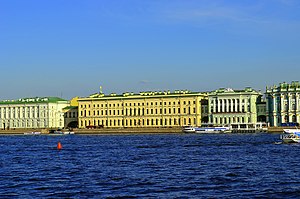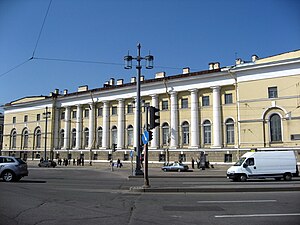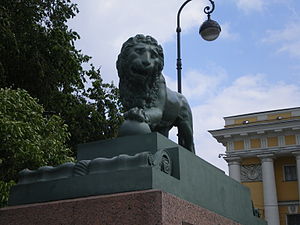Country:
Region:
City:
Latitude and Longitude:
Time Zone:
Postal Code:
IP information under different IP Channel
ip-api
Country
Region
City
ASN
Time Zone
ISP
Blacklist
Proxy
Latitude
Longitude
Postal
Route
Luminati
Country
Region
spe
City
stpetersburg
ASN
Time Zone
Europe/Moscow
ISP
SkyNet Ltd.
Latitude
Longitude
Postal
IPinfo
Country
Region
City
ASN
Time Zone
ISP
Blacklist
Proxy
Latitude
Longitude
Postal
Route
db-ip
Country
Region
City
ASN
Time Zone
ISP
Blacklist
Proxy
Latitude
Longitude
Postal
Route
ipdata
Country
Region
City
ASN
Time Zone
ISP
Blacklist
Proxy
Latitude
Longitude
Postal
Route
Popular places and events near this IP address

Hermitage Museum
Museum in Saint Petersburg, Russia
Distance: Approx. 257 meters
Latitude and longitude: 59.94055556,30.31361111
The State Hermitage Museum (Russian: Государственный Эрмитаж, romanized: Gosudarstvennyj Ermitaž, IPA: [ɡəsʊˈdarstvʲɪn(ː)ɨj ɪrmʲɪˈtaʂ]) is a museum of art and culture in Saint Petersburg, Russia. It was founded in 1764 when Empress Catherine the Great acquired a collection of paintings from the Berlin merchant Johann Ernst Gotzkowsky. The museum celebrates the anniversary of its founding each year on 7 December, Saint Catherine's Day.

Palace Bridge
Bridge in Saint Petersburg
Distance: Approx. 103 meters
Latitude and longitude: 59.941149,30.308105
Palace Bridge (Russian: Дворцо́вый мост, Dvortsoviy Most), a road- and foot-traffic bascule bridge, spans the Neva River in Saint Petersburg between Palace Square and Vasilievsky Island. Like every other Neva bridge (except for Big Obukhovsky Bridge), it is drawn by night, making foot travel between various parts of the city virtually impossible. The bascule span was designed by an American firm, the Scherzer Rolling Lift Bridge Company, and built by the French firm Société de Construction des Batignolles between 1912 and 1916.

Zoological Museum (Saint Petersburg)
Russian zoological museum
Distance: Approx. 244 meters
Latitude and longitude: 59.9426,30.3056
The Zoological Museum of the Zoological Institute of the Russian Academy of Sciences is a Russian museum devoted to zoology. It is located in Saint Petersburg, on Universitetskaya Embankment. It is one of the ten largest nature history museums in the world.

Palace Embankment
Distance: Approx. 177 meters
Latitude and longitude: 59.941232,30.312629
The Palace Embankment or Palace Quay (Russian: Дворцовая набережная, Dvortsovaya naberezhnaya) is a street along the Neva River in Central Saint Petersburg which contains the complex of the Hermitage Museum buildings (including the Winter Palace), the Hermitage Theatre, the New Michael Palace, the Saltykov Mansion and the Summer Garden. The embankment was wooden up to 1761, when Catherine the Great ordered court architect Yury Felten to build stone embankments. The street as seen nowadays was laid out between 1763 and 1767, when it used to be a preferred place of residence for the Russian Imperial Nobility.
Stone of Tmutarakan
Distance: Approx. 190 meters
Latitude and longitude: 59.9409,30.3126
The Stone of Tmutarakan (Russian: Тмутараканский камень) is a marble slab engraved with the words "In the year 6576 [ A.M., 1068 A.D] the sixth of the Indiction, Prince Gleb measured across the sea on the ice from Tmutarakan to Kerch 14,000 sazhen" («В лето 6576 индикта 6 Глеб князь мерил море по леду от Тмутороканя до Корчева 14000 сажен»). A sazhen, an old Rus unit of length, was equal to seven feet (or corresponded roughly to a fathom); thus the Kerch Straits, according to the stone, were 88,000 feet or 18.5 miles across (that is, from Kerch to Tmutarakan — the straits themselves are only 4.5 miles wide at their narrowest point, but the distance from the site of Tmutarakan to modern-day Kerch is about 15 miles.) The tenth-century Byzantine Emperor Constantine Porphyrogenitus wrote that the straits were the equivalent of 18 miles across, and this might explain why that measurement appears on the stone, although it is unclear if an eleventh-century prince in Rus would have had access to that information; this uncertainty calls the stone's authenticity into question. The Prince Gleb referred to in the inscription was Gleb Svyatoslavich, then prince of Tmutarakan.

Winter Palace
Former imperial palace in Saint Petersburg, Russia
Distance: Approx. 280 meters
Latitude and longitude: 59.9404,30.3139
The Winter Palace is a palace in Saint Petersburg that served as the official residence of the House of Romanov, previous emperors, from 1732 to 1917. The palace and its precincts now house the Hermitage Museum. The floor area is 233,345 square metres (it has been calculated that the palace contains 1,886 doors, 1,945 windows, 1,500 rooms and 117 staircases).

Jordan Staircase of the Winter Palace
Staircase in the Winter Palace, St. Petersburg
Distance: Approx. 255 meters
Latitude and longitude: 59.9413,30.3141
The principal or Jordan Staircase of the Winter Palace, St Petersburg is so called because on the Feast of the Epiphany the Tsar descended this imperial staircase in state for the ceremony of the "Blessing of the Waters" of the Neva River, a celebration of Christ's baptism in the Jordan River. The staircase is one of the few parts of the palace retaining the original 18th-century style. The massive grey granite columns, however, were added in the mid 19th century.

Gardens of the Winter Palace
Distance: Approx. 275 meters
Latitude and longitude: 59.9394,30.3114
The gardens of the Winter Palace, St Petersburg, are little known, as the great imperial palace of the Romanovs was never intended to have gardens. As the Tsar's principal residence, situated in the capital, it was very much intended as a symbol of power rather than a place of relaxation and pleasure. Bordered by the River Neva on its northern side and Palace Square on its southern, the Winter Palace was devoid of space for gardens; however, the last two empresses of Russia each created gardens from previously paved areas.

Neva Enfilade of the Winter Palace
Distance: Approx. 280 meters
Latitude and longitude: 59.9404,30.3139
The Neva Enfilade of the Winter Palace, St Petersburg, is a series of three large halls arranged in an enfilade along the palace's massive facade facing the River Neva. Originally designed as a series of five state rooms by the architect Francesco Rastrelli in 1753, they were transformed into an enfilade of three vast halls in 1790 by Giacomo Quarenghi. Following a fire in 1837 they were rebuilt under the direction of Vasily Stasov.

Fire in the Winter Palace
1837 fire in Saint Petersburg, Russian Empire
Distance: Approx. 280 meters
Latitude and longitude: 59.9404,30.3139
The fire in the Winter Palace of Saint Petersburg, then the official residence of the Russian emperors, occurred on December 17, 1837, and was caused by soot inflammation. The Palace burned for three days, and the glow was visible for 50–70 versts (50–75 km / 30–45 mi). Thirty guardsmen died in the fire, although nearly all the items were saved (notably the imperial throne, guards banners, portraits of Russian generals from the Field Marshals' Hall and Military Gallery and the utensils of the Grand Church).

Private Apartments of the Winter Palace
Distance: Approx. 280 meters
Latitude and longitude: 59.9404,30.3139
The Private Apartments of the Winter Palace are sited on the piano nobile of the western wing of the former imperial palace, the Winter Palace in St Petersburg. Access to the private rooms, for members of the imperial family, from the exterior was usually through the Saltykov Entrance (centre in the photograph to the right) which was reserved for use by only the Tsar, Tsaritsa and grand dukes and grand duchesses. A second access was through a discrete box-like porch, on the western end of the palace's Neva façade.
Lions at the Dvortsovaya pier
Distance: Approx. 224 meters
Latitude and longitude: 59.93972222,30.30888889
The Lions at the Dvortsovaya pier are two lion sculptures in bronze placed at the Admiralty embankment in Saint Petersburg since 1832. The lions are copies of the late 16th century Italian Medici lions in Florence. The lions are the best known among several Medici lions and other lion sculptures in Saint Petersburg.
Weather in this IP's area
few clouds
2 Celsius
-1 Celsius
0 Celsius
2 Celsius
1004 hPa
90 %
1004 hPa
1004 hPa
10000 meters
4 m/s
280 degree
20 %
08:56:59
16:30:03
